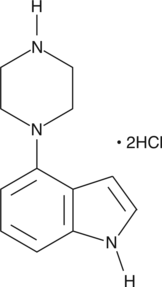Chemicals
Showing 5551–5700 of 41137 results
-
3′-Deoxyguanosine is a ligand that can be complexed with enzymes, such as purine nucleoside phosphorylase, and receptors, in order to study structure-activity relationships.{29082,29083} This compound can also be used to selectively impair transcription.{29084}
Brand:CaymanSKU:-Available on backorder
3′-Deoxyguanosine is a ligand that can be complexed with enzymes, such as purine nucleoside phosphorylase, and receptors, in order to study structure-activity relationships.{29082,29083} This compound can also be used to selectively impair transcription.{29084}
Brand:CaymanSKU:-Available on backorder
3′-Dephosphocoenzyme A is an intermediate in the biosynthesis of coenzyme A (CoA; Item Nos. 16147 | 21499 | 21722) from pantothenic acid (vitamin B5; Item No. 17288).{18936} It is phosphorylated by CoA synthase in humans to form CoA. 3′-Dephosphocoenzyme A can be used as a transcription initiator in the synthesis of CoA-RNA by in vitro transcription.{42888,42889}
Brand:CaymanSKU:27390 - 1 mgAvailable on backorder
3′-Dephosphocoenzyme A is an intermediate in the biosynthesis of coenzyme A (CoA; Item Nos. 16147 | 21499 | 21722) from pantothenic acid (vitamin B5; Item No. 17288).{18936} It is phosphorylated by CoA synthase in humans to form CoA. 3′-Dephosphocoenzyme A can be used as a transcription initiator in the synthesis of CoA-RNA by in vitro transcription.{42888,42889}
Brand:CaymanSKU:27390 - 10 mgAvailable on backorder
3′-Dephosphocoenzyme A is an intermediate in the biosynthesis of coenzyme A (CoA; Item Nos. 16147 | 21499 | 21722) from pantothenic acid (vitamin B5; Item No. 17288).{18936} It is phosphorylated by CoA synthase in humans to form CoA. 3′-Dephosphocoenzyme A can be used as a transcription initiator in the synthesis of CoA-RNA by in vitro transcription.{42888,42889}
Brand:CaymanSKU:27390 - 5 mgAvailable on backorder
Brand:CaymanSKU:26664 - 1 mgAvailable on backorder
Brand:CaymanSKU:26664 - 5 mgAvailable on backorder
3′-Ethoxy-5,6-dihydro spinosyn J 17-pseudoaglycone is a degradation product of 3’-ethoxy-5,6-dihydro spinosyn J, a component of the insecticide spinosyn J.{45037,45038} It has no insecticidal activity against the tobacco budworm up to a concentration of 64 ppm.{45038}
Brand:CaymanSKU:25765 - 1 mgAvailable on backorder
3′-Ethoxy-5,6-dihydro spinosyn J 17-pseudoaglycone is a degradation product of 3’-ethoxy-5,6-dihydro spinosyn J, a component of the insecticide spinosyn J.{45037,45038} It has no insecticidal activity against the tobacco budworm up to a concentration of 64 ppm.{45038}
Brand:CaymanSKU:25765 - 5 mgAvailable on backorder
The α-pyrrioldinophenones (α-PPPs) are a class of designer drugs, typified by α-PPP (Item No. 10445) and 4’-methyl-α-PPP (Item No. 10446).{19737,19193,19508} Although structurally related to amphetamines and cathinones, the pharmacology and toxicology of members of this class have not been elucidated.{19874} 3’-fluoro-α-PPP is a derivative of α-PPP, characterized by the addition of a fluorine group at the 3 position of the phenyl ring. The physiological and toxicological properties of this compound are not known. This product is intended for forensic and research applications.
Brand:CaymanSKU:-The α-pyrrioldinophenones (α-PPPs) are a class of designer drugs, typified by α-PPP (Item No. 10445) and 4’-methyl-α-PPP (Item No. 10446).{19737,19193,19508} Although structurally related to amphetamines and cathinones, the pharmacology and toxicology of members of this class have not been elucidated.{19874} 3’-fluoro-α-PPP is a derivative of α-PPP, characterized by the addition of a fluorine group at the 3 position of the phenyl ring. The physiological and toxicological properties of this compound are not known. This product is intended for forensic and research applications.
Brand:CaymanSKU:-The α-pyrrioldinophenones (α-PPPs) are a class of designer drugs, typified by α-PPP (Item No. 10445) and 4’-methyl-α-PPP (Item No. 10446).{19737,19193,19508} Although structurally related to amphetamines and cathinones, the pharmacology and toxicology of members of this class have not been elucidated.{19874} 3’-fluoro-α-PPP is a derivative of α-PPP, characterized by the addition of a fluorine group at the 3 position of the phenyl ring. The physiological and toxicological properties of this compound are not known. This product is intended for forensic and research applications.
Brand:CaymanSKU:-3’-hydroxy Lidocaine is an active metabolite of lidocaine formed by the cytochrome P450 (CYP) isoforms CYP1A2 and CYP3A4.{40104,40103}
Brand:CaymanSKU:22899 - 1 mgAvailable on backorder
3’-hydroxy Lidocaine is an active metabolite of lidocaine formed by the cytochrome P450 (CYP) isoforms CYP1A2 and CYP3A4.{40104,40103}
Brand:CaymanSKU:22899 - 10 mgAvailable on backorder
3’-hydroxy Lidocaine is an active metabolite of lidocaine formed by the cytochrome P450 (CYP) isoforms CYP1A2 and CYP3A4.{40104,40103}
Brand:CaymanSKU:22899 - 5 mgAvailable on backorder
3’-hydroxy Lidocaine is an active metabolite of lidocaine formed by the cytochrome P450 (CYP) isoforms CYP1A2 and CYP3A4.{40104,40103}
Brand:CaymanSKU:22899 - 500 µgAvailable on backorder
3′-hydroxy Stanozolol (Item No. 21380) is an analytical reference standard and a major metabolite of the anabolic androgenic steroid stanozolol (Item No. 21167).{39251} This product is intended for research and forensic applications.
Brand:CaymanSKU:21380 -Out of stock
3′-hydroxy Stanozolol (Item No. 21380) is an analytical reference standard and a major metabolite of the anabolic androgenic steroid stanozolol (Item No. 21167).{39251} This product is intended for research and forensic applications.
Brand:CaymanSKU:21380 -Out of stock
3′-Sialyllactose consists of the monosaccharide N-acetylneuraminic acid linked to the galactosyl subunit of lactose at the 3 position. It is an abundant oligosaccharide in the milk of many mammals, including cows and humans, particularly postpartum.{27235,27232} 3′-Sialyllactose avidly binds several viral strains, including strains of influenza, HIV-1, reovirus, and polyomavirus.{27234,27230,27228,27229} In some cases, binding of 3’-sialyllactose to viral proteins alters viral infectivity.{27234,27230,27228} 3′-Sialyllactose also alters Helicobacter activity and impacts bacterial colonization of gut.{27231,27233}
Brand:CaymanSKU:-Out of stock
3′-Sialyllactose consists of the monosaccharide N-acetylneuraminic acid linked to the galactosyl subunit of lactose at the 3 position. It is an abundant oligosaccharide in the milk of many mammals, including cows and humans, particularly postpartum.{27235,27232} 3′-Sialyllactose avidly binds several viral strains, including strains of influenza, HIV-1, reovirus, and polyomavirus.{27234,27230,27228,27229} In some cases, binding of 3’-sialyllactose to viral proteins alters viral infectivity.{27234,27230,27228} 3′-Sialyllactose also alters Helicobacter activity and impacts bacterial colonization of gut.{27231,27233}
Brand:CaymanSKU:-Out of stock
3′-Sialyllactose consists of the monosaccharide N-acetylneuraminic acid linked to the galactosyl subunit of lactose at the 3 position. It is an abundant oligosaccharide in the milk of many mammals, including cows and humans, particularly postpartum.{27235,27232} 3′-Sialyllactose avidly binds several viral strains, including strains of influenza, HIV-1, reovirus, and polyomavirus.{27234,27230,27228,27229} In some cases, binding of 3’-sialyllactose to viral proteins alters viral infectivity.{27234,27230,27228} 3′-Sialyllactose also alters Helicobacter activity and impacts bacterial colonization of gut.{27231,27233}
Brand:CaymanSKU:-Out of stock
3′-Sialyllactose consists of the monosaccharide N-acetylneuraminic acid linked to the galactosyl subunit of lactose at the 3 position. It is an abundant oligosaccharide in the milk of many mammals, including cows and humans, particularly postpartum.{27235,27232} 3′-Sialyllactose avidly binds several viral strains, including strains of influenza, HIV-1, reovirus, and polyomavirus.{27234,27230,27228,27229} In some cases, binding of 3’-sialyllactose to viral proteins alters viral infectivity.{27234,27230,27228} 3′-Sialyllactose also alters Helicobacter activity and impacts bacterial colonization of gut.{27231,27233}
Brand:CaymanSKU:-Out of stock
3′,4′-Dihydroxyphenylacetone (Item No. 19522) is an analytical reference standard. It is a minor metabolite of 3,4-MDEA (Item Nos. 14085 | 15689), MDMA, and α-methyldopa produced by oxidative deamination.{31615,31614,31613} This product is intended for forensic and research applications.
Brand:CaymanSKU:-Available on backorder
3′,4′-Dihydroxyphenylacetone (Item No. 19522) is an analytical reference standard. It is a minor metabolite of 3,4-MDEA (Item Nos. 14085 | 15689), MDMA, and α-methyldopa produced by oxidative deamination.{31615,31614,31613} This product is intended for forensic and research applications.
Brand:CaymanSKU:-Available on backorder
3′,4′-Dihydroxyphenylacetone (Item No. 19522) is an analytical reference standard. It is a minor metabolite of 3,4-MDEA (Item Nos. 14085 | 15689), MDMA, and α-methyldopa produced by oxidative deamination.{31615,31614,31613} This product is intended for forensic and research applications.
Brand:CaymanSKU:-Available on backorder
3′,4′-Dihydroxyphenylacetone (Item No. 19522) is an analytical reference standard. It is a minor metabolite of 3,4-MDEA (Item Nos. 14085 | 15689), MDMA, and α-methyldopa produced by oxidative deamination.{31615,31614,31613} This product is intended for forensic and research applications.
Brand:CaymanSKU:-Available on backorder
3′,4′,7-Trihydroxyisoflavone is a natural isoflavonoid that has antioxidant activity.{33338} It can be produced by the metabolism of daidzein (Item No. 10005166) or daidzin (Item No. 13202).{33337,33342} 3′,4′,7-Trihydroxyisoflavone inhibits several signaling pathways in cells, including tyrosinase-mediated melanin formation (IC50 = 5.2 µM), casein kinase II-mediated phosphorylation of 60S acidic ribosomal P proteins, and cyclin-dependent, kinase-regulated cell proliferation.{33341,33340,33339}
Brand:CaymanSKU:20930 -Out of stock
3′,4′,7-Trihydroxyisoflavone is a natural isoflavonoid that has antioxidant activity.{33338} It can be produced by the metabolism of daidzein (Item No. 10005166) or daidzin (Item No. 13202).{33337,33342} 3′,4′,7-Trihydroxyisoflavone inhibits several signaling pathways in cells, including tyrosinase-mediated melanin formation (IC50 = 5.2 µM), casein kinase II-mediated phosphorylation of 60S acidic ribosomal P proteins, and cyclin-dependent, kinase-regulated cell proliferation.{33341,33340,33339}
Brand:CaymanSKU:20930 -Out of stock
3′,4′,7-Trihydroxyisoflavone is a natural isoflavonoid that has antioxidant activity.{33338} It can be produced by the metabolism of daidzein (Item No. 10005166) or daidzin (Item No. 13202).{33337,33342} 3′,4′,7-Trihydroxyisoflavone inhibits several signaling pathways in cells, including tyrosinase-mediated melanin formation (IC50 = 5.2 µM), casein kinase II-mediated phosphorylation of 60S acidic ribosomal P proteins, and cyclin-dependent, kinase-regulated cell proliferation.{33341,33340,33339}
Brand:CaymanSKU:20930 -Out of stock
3′,4′,7-Trihydroxyisoflavone is a natural isoflavonoid that has antioxidant activity.{33338} It can be produced by the metabolism of daidzein (Item No. 10005166) or daidzin (Item No. 13202).{33337,33342} 3′,4′,7-Trihydroxyisoflavone inhibits several signaling pathways in cells, including tyrosinase-mediated melanin formation (IC50 = 5.2 µM), casein kinase II-mediated phosphorylation of 60S acidic ribosomal P proteins, and cyclin-dependent, kinase-regulated cell proliferation.{33341,33340,33339}
Brand:CaymanSKU:20930 -Out of stock
3’-sulfo Galactosylsphingosine is a form of sulfatide (Item No. 24323) that is lacking the fatty acyl group. It decreases migration and adhesion of B35 neuroblastoma cells and increases cell rounding when used at a concentration of 20 µM.{43066} It also inhibits PKC and cytochrome c oxidase activity when used at concentrations of 150 and 50-100 µM, respectively.{43067} 3’-sulfo Galactosylsphingosine accumulates in patients with metachromatic leukodystrophy, a lysosomal storage disorder characterized by arylsulfatase A (ASA) deficiency leading to progressive demyelination and neuromotor deficits.{43068} In mice lacking ASA, levels of 3’-sulfo galactosylsphingosine increase after one month of age followed by demyelination and neuromotor deficits.{43067,43068} 3’-sulfo Galactosylsphingosine has been used as a standard for the quantification of 3’-sulfo galactosylsphingosine by LC-MS.{38965} [Matreya, LLC. Catalog No. 1904]
Brand:CaymanSKU:25316 - 1 mgAvailable on backorder
30-hydroxy Triacontanoic acid methyl ester is a hydroxylated fatty acid methyl ester that has been found in sediment samples from the Harney River.{38856} [Matreya, LLC. Catalog No. 1884]
Brand:CaymanSKU:24808 - 10 mgAvailable on backorder
30-hydroxy Triacontanoic acid methyl ester is a hydroxylated fatty acid methyl ester that has been found in sediment samples from the Harney River.{38856} [Matreya, LLC. Catalog No. 1884]
Brand:CaymanSKU:24808 - 25 mgAvailable on backorder
30-hydroxy Triacontanoic acid methyl ester is a hydroxylated fatty acid methyl ester that has been found in sediment samples from the Harney River.{38856} [Matreya, LLC. Catalog No. 1884]
Brand:CaymanSKU:24808 - 5 mgAvailable on backorder
A group of phenethylamine derivatives referred to as the FLY compounds, named for their insect-like appearance of two “wing-like” furan or dihydrofuran rings fused on the opposite sides of the central benzene ring, have been identified with allegedly potent hallucinogenic effects.{21377} 2C-B-fly is the dihydrodifuran analog of the Schedule I hallucinogen 4-bromo-2,5-dimethoxyphenethylamine (2C-B), a partial agonist at the 5-HT2A serotonin receptor with high affinity for 5-HT2B and 5-HT2C.{21377,21380,21379} 3C-B-fly is an α-methylated analog of 2C-B-fly. This compound is also the dihydrofuran analog of 4-bromo-2,5-dimethoxyamphetamine (Item No. 11142), which is a potent agonist of 5-HT2A and 5-HT2C.{21376} The physiological and toxicological properties of 3C-B-fly are not known. This product is intended for forensic and research purposes.
Brand:CaymanSKU:-A group of phenethylamine derivatives referred to as the FLY compounds, named for their insect-like appearance of two “wing-like” furan or dihydrofuran rings fused on the opposite sides of the central benzene ring, have been identified with allegedly potent hallucinogenic effects.{21377} 2C-B-fly is the dihydrodifuran analog of the Schedule I hallucinogen 4-bromo-2,5-dimethoxyphenethylamine (2C-B), a partial agonist at the 5-HT2A serotonin receptor with high affinity for 5-HT2B and 5-HT2C.{21377,21380,21379} 3C-B-fly is an α-methylated analog of 2C-B-fly. This compound is also the dihydrofuran analog of 4-bromo-2,5-dimethoxyamphetamine (Item No. 11142), which is a potent agonist of 5-HT2A and 5-HT2C.{21376} The physiological and toxicological properties of 3C-B-fly are not known. This product is intended for forensic and research purposes.
Brand:CaymanSKU:-A group of phenethylamine derivatives referred to as the FLY compounds, named for their insect-like appearance of two “wing-like” furan or dihydrofuran rings fused on the opposite sides of the central benzene ring, have been identified with allegedly potent hallucinogenic effects.{21377} 2C-B-fly is the dihydrodifuran analog of the Schedule I hallucinogen 4-bromo-2,5-dimethoxyphenethylamine (2C-B), a partial agonist at the 5-HT2A serotonin receptor with high affinity for 5-HT2B and 5-HT2C.{21377,21380,21379} 3C-B-fly is an α-methylated analog of 2C-B-fly. This compound is also the dihydrofuran analog of 4-bromo-2,5-dimethoxyamphetamine (Item No. 11142), which is a potent agonist of 5-HT2A and 5-HT2C.{21376} The physiological and toxicological properties of 3C-B-fly are not known. This product is intended for forensic and research purposes.
Brand:CaymanSKU:-3CAI is an inhibitor of Akt1 and Akt2 with anticancer activity.{41924} It inhibits Akt1 and Akt2 in a kinase assay in a concentration-dependent manner, but has no effect on MEK1, JNK1, ERK1, or PDZ binding kinase (PBK) when used at a concentration of 1 µM. 3CAI (4 µM) increases apoptosis in HCT116 and HT-29 colon cancer cells and inhibits the growth of HCT116 cells in vitro in a concentration-dependent manner. Oral administration of 3CAI (30 mg/kg) reduces tumor growth in an HCT116 mouse xenograft model. It also decreases status epilepticus-induced vasogenic edema to 0.46-fold of vehicle control levels and reduces increases in endothelial nitric oxide synthase (eNOS) levels in the piriform cortex in rats when administered at a dose of 25 µM.{41925}
Brand:CaymanSKU:-3CAI is an inhibitor of Akt1 and Akt2 with anticancer activity.{41924} It inhibits Akt1 and Akt2 in a kinase assay in a concentration-dependent manner, but has no effect on MEK1, JNK1, ERK1, or PDZ binding kinase (PBK) when used at a concentration of 1 µM. 3CAI (4 µM) increases apoptosis in HCT116 and HT-29 colon cancer cells and inhibits the growth of HCT116 cells in vitro in a concentration-dependent manner. Oral administration of 3CAI (30 mg/kg) reduces tumor growth in an HCT116 mouse xenograft model. It also decreases status epilepticus-induced vasogenic edema to 0.46-fold of vehicle control levels and reduces increases in endothelial nitric oxide synthase (eNOS) levels in the piriform cortex in rats when administered at a dose of 25 µM.{41925}
Brand:CaymanSKU:-3CAI is an inhibitor of Akt1 and Akt2 with anticancer activity.{41924} It inhibits Akt1 and Akt2 in a kinase assay in a concentration-dependent manner, but has no effect on MEK1, JNK1, ERK1, or PDZ binding kinase (PBK) when used at a concentration of 1 µM. 3CAI (4 µM) increases apoptosis in HCT116 and HT-29 colon cancer cells and inhibits the growth of HCT116 cells in vitro in a concentration-dependent manner. Oral administration of 3CAI (30 mg/kg) reduces tumor growth in an HCT116 mouse xenograft model. It also decreases status epilepticus-induced vasogenic edema to 0.46-fold of vehicle control levels and reduces increases in endothelial nitric oxide synthase (eNOS) levels in the piriform cortex in rats when administered at a dose of 25 µM.{41925}
Brand:CaymanSKU:-In several model organisms, the generation of conditional analog-sensitive kinase alleles has been developed as a chemical genetic strategy wherein a mutational enlargement of the ATP-binding site enables a protein kinase to interact with bulky ATP analogs.{28954,28952} Thus, a generic bulky ATP analog can competitively inhibit the activity of the mutant kinase, without interfering with the function of wild-type kinases whose ATP-binding pockets remain too small to accommodate the bulky analog. 3MB-PP1 is a bulky purine analog that acts as a selective, ATP-competitive, analog-sensitive polo-like kinase 1 (Plk1) allele inhibitor.{28953} At 10 µM, it can block mitotic progression in cells expressing analog-sensitive Plk1 alleles and has been used to selectively sensitize Plk1 to small-molecule inhibitors.{28952,28953}
Brand:CaymanSKU:-Available on backorder
In several model organisms, the generation of conditional analog-sensitive kinase alleles has been developed as a chemical genetic strategy wherein a mutational enlargement of the ATP-binding site enables a protein kinase to interact with bulky ATP analogs.{28954,28952} Thus, a generic bulky ATP analog can competitively inhibit the activity of the mutant kinase, without interfering with the function of wild-type kinases whose ATP-binding pockets remain too small to accommodate the bulky analog. 3MB-PP1 is a bulky purine analog that acts as a selective, ATP-competitive, analog-sensitive polo-like kinase 1 (Plk1) allele inhibitor.{28953} At 10 µM, it can block mitotic progression in cells expressing analog-sensitive Plk1 alleles and has been used to selectively sensitize Plk1 to small-molecule inhibitors.{28952,28953}
Brand:CaymanSKU:-Available on backorder
In several model organisms, the generation of conditional analog-sensitive kinase alleles has been developed as a chemical genetic strategy wherein a mutational enlargement of the ATP-binding site enables a protein kinase to interact with bulky ATP analogs.{28954,28952} Thus, a generic bulky ATP analog can competitively inhibit the activity of the mutant kinase, without interfering with the function of wild-type kinases whose ATP-binding pockets remain too small to accommodate the bulky analog. 3MB-PP1 is a bulky purine analog that acts as a selective, ATP-competitive, analog-sensitive polo-like kinase 1 (Plk1) allele inhibitor.{28953} At 10 µM, it can block mitotic progression in cells expressing analog-sensitive Plk1 alleles and has been used to selectively sensitize Plk1 to small-molecule inhibitors.{28952,28953}
Brand:CaymanSKU:-Available on backorder
3PO is a competitive inhibitor of 6-phosphofructo-2-kinase/fructose-2,6-bisphosphate 3 (PFKFB3; IC50 = 23 µM) that causes a rapid reduction in fructose-2,6-bisphosphate (F2,6BP), glucose uptake, and lactate secretion.{31403,30752} This is followed by a reduction in the steady-state concentration of ATP and NADH, resulting in cell cycle arrest in Jurkat T cell leukemia cells.{31403,30752} 3PO is selectively cytostatic to ras-transformed bronchial epithelial cells relative to normal bronchial epithelial cells.{31403} 3PO markedly reduces intracellular F2,6BP, glucose uptake, and growth of established tumors in mice.{31403} It also blocks angiogenesis, reducing vessel sprouting in endothelial cell spheroids, zebrafish embryos, and the postnatal mouse retina by inhibiting endothelial cell proliferation and migration.{31404}
Brand:CaymanSKU:-Available on backorder
3PO is a competitive inhibitor of 6-phosphofructo-2-kinase/fructose-2,6-bisphosphate 3 (PFKFB3; IC50 = 23 µM) that causes a rapid reduction in fructose-2,6-bisphosphate (F2,6BP), glucose uptake, and lactate secretion.{31403,30752} This is followed by a reduction in the steady-state concentration of ATP and NADH, resulting in cell cycle arrest in Jurkat T cell leukemia cells.{31403,30752} 3PO is selectively cytostatic to ras-transformed bronchial epithelial cells relative to normal bronchial epithelial cells.{31403} 3PO markedly reduces intracellular F2,6BP, glucose uptake, and growth of established tumors in mice.{31403} It also blocks angiogenesis, reducing vessel sprouting in endothelial cell spheroids, zebrafish embryos, and the postnatal mouse retina by inhibiting endothelial cell proliferation and migration.{31404}
Brand:CaymanSKU:-Available on backorder
3PO is a competitive inhibitor of 6-phosphofructo-2-kinase/fructose-2,6-bisphosphate 3 (PFKFB3; IC50 = 23 µM) that causes a rapid reduction in fructose-2,6-bisphosphate (F2,6BP), glucose uptake, and lactate secretion.{31403,30752} This is followed by a reduction in the steady-state concentration of ATP and NADH, resulting in cell cycle arrest in Jurkat T cell leukemia cells.{31403,30752} 3PO is selectively cytostatic to ras-transformed bronchial epithelial cells relative to normal bronchial epithelial cells.{31403} 3PO markedly reduces intracellular F2,6BP, glucose uptake, and growth of established tumors in mice.{31403} It also blocks angiogenesis, reducing vessel sprouting in endothelial cell spheroids, zebrafish embryos, and the postnatal mouse retina by inhibiting endothelial cell proliferation and migration.{31404}
Brand:CaymanSKU:-Available on backorder
3α-Aminocholestane is an inhibitor of SH2 domain-containing inositol-5’-phosphatase 1 (SHP-1; IC50 = ~2.5 µM).{35841} It is selective for SHP-1 over SHP-2 and phosphatase and tensin homolog (PTEN; IC50s = >20 µM). 3α-Aminocholestane induces hyperactivation of the tyrosine kinase SYK in patient-derived Ph+ acute lymphoblastic leukemia (ALL) cells and selectively induces cytotoxicity in these cells over mature B cell lymphoma cells. It reduces leukemia burden and increases survival in a tyrosine kinase inhibitor-resistant patient-derived Ph+ ALL mouse xenograft model when administered at a dose of 50 mg/kg. 3α-Aminocholestane reduces cell viability of OPM2 multiple myeloma (MM) cells in a concentration-dependent manner and of RPMI8226 MM cells when used at concentrations greater than or equal to 12.5 µM.{35843} It halts the cell cycle at the G0/G1 or G2/M stages in the highly proliferative OPM2 or less proliferative RPMI8226 cell lines, respectively. It induces apoptosis via activation of caspase-3, caspase-9, and poly(ADP-ribose) polymerase (PARP) in OPM2 cells but not in RPMI8226 cells. 3α-Aminocholestane reduces tumor burden and increases survival in an OPM2 mouse xenograft model.
Brand:CaymanSKU:27885 - 1 mgAvailable on backorder
3α-Aminocholestane is an inhibitor of SH2 domain-containing inositol-5’-phosphatase 1 (SHP-1; IC50 = ~2.5 µM).{35841} It is selective for SHP-1 over SHP-2 and phosphatase and tensin homolog (PTEN; IC50s = >20 µM). 3α-Aminocholestane induces hyperactivation of the tyrosine kinase SYK in patient-derived Ph+ acute lymphoblastic leukemia (ALL) cells and selectively induces cytotoxicity in these cells over mature B cell lymphoma cells. It reduces leukemia burden and increases survival in a tyrosine kinase inhibitor-resistant patient-derived Ph+ ALL mouse xenograft model when administered at a dose of 50 mg/kg. 3α-Aminocholestane reduces cell viability of OPM2 multiple myeloma (MM) cells in a concentration-dependent manner and of RPMI8226 MM cells when used at concentrations greater than or equal to 12.5 µM.{35843} It halts the cell cycle at the G0/G1 or G2/M stages in the highly proliferative OPM2 or less proliferative RPMI8226 cell lines, respectively. It induces apoptosis via activation of caspase-3, caspase-9, and poly(ADP-ribose) polymerase (PARP) in OPM2 cells but not in RPMI8226 cells. 3α-Aminocholestane reduces tumor burden and increases survival in an OPM2 mouse xenograft model.
Brand:CaymanSKU:27885 - 10 mgAvailable on backorder
3α-Aminocholestane is an inhibitor of SH2 domain-containing inositol-5’-phosphatase 1 (SHP-1; IC50 = ~2.5 µM).{35841} It is selective for SHP-1 over SHP-2 and phosphatase and tensin homolog (PTEN; IC50s = >20 µM). 3α-Aminocholestane induces hyperactivation of the tyrosine kinase SYK in patient-derived Ph+ acute lymphoblastic leukemia (ALL) cells and selectively induces cytotoxicity in these cells over mature B cell lymphoma cells. It reduces leukemia burden and increases survival in a tyrosine kinase inhibitor-resistant patient-derived Ph+ ALL mouse xenograft model when administered at a dose of 50 mg/kg. 3α-Aminocholestane reduces cell viability of OPM2 multiple myeloma (MM) cells in a concentration-dependent manner and of RPMI8226 MM cells when used at concentrations greater than or equal to 12.5 µM.{35843} It halts the cell cycle at the G0/G1 or G2/M stages in the highly proliferative OPM2 or less proliferative RPMI8226 cell lines, respectively. It induces apoptosis via activation of caspase-3, caspase-9, and poly(ADP-ribose) polymerase (PARP) in OPM2 cells but not in RPMI8226 cells. 3α-Aminocholestane reduces tumor burden and increases survival in an OPM2 mouse xenograft model.
Brand:CaymanSKU:27885 - 5 mgAvailable on backorder
3β-hydroxy-5-Cholestenoic acid is an active metabolite of cholesterol formed when cholesterol is metabolized by the cytochrome P450 (CYP) isomer CYP27A1.{41086} 3β-hydroxy-5-Cholestenoic acid is a modulator of γ-secretase that decreases amyloid β (1-42) peptide (Aβ42; EC50 = 250 nM) and increases Aβ38 levels with no effect on total Aβ in CHO2B7 cells. It decreases endogenous murine Aβ42 production by 60 and 75% in mouse postnatal neuron-glia cultures at concentrations of 3 and 10 μM, respectively.
Brand:CaymanSKU:21859 -Out of stock
3β-hydroxy-5-Cholestenoic acid is an active metabolite of cholesterol formed when cholesterol is metabolized by the cytochrome P450 (CYP) isomer CYP27A1.{41086} 3β-hydroxy-5-Cholestenoic acid is a modulator of γ-secretase that decreases amyloid β (1-42) peptide (Aβ42; EC50 = 250 nM) and increases Aβ38 levels with no effect on total Aβ in CHO2B7 cells. It decreases endogenous murine Aβ42 production by 60 and 75% in mouse postnatal neuron-glia cultures at concentrations of 3 and 10 μM, respectively.
Brand:CaymanSKU:21859 -Out of stock
3β-OH-7-Oxocholenic acid is a bile acid.{46712} It is also a metabolite of 7β-hydroxy cholesterol (Item No. 20099) in rats. Conjugated forms of 3β-OH-7-oxocholenic acid have been found in the urine of patients with Neimann-Pick disease type C.{46713,46714}
Brand:CaymanSKU:29541 - 1 mgAvailable on backorder
3β-OH-7-Oxocholenic acid is a bile acid.{46712} It is also a metabolite of 7β-hydroxy cholesterol (Item No. 20099) in rats. Conjugated forms of 3β-OH-7-oxocholenic acid have been found in the urine of patients with Neimann-Pick disease type C.{46713,46714}
Brand:CaymanSKU:29541 - 5 mgAvailable on backorder
3β-OH-7-Oxocholenic acid is a bile acid.{46712} It is also a metabolite of 7β-hydroxy cholesterol (Item No. 20099) in rats. Conjugated forms of 3β-OH-7-oxocholenic acid have been found in the urine of patients with Neimann-Pick disease type C.{46713,46714}
Brand:CaymanSKU:29541 - 500 µgAvailable on backorder
4-(1-piperazinyl)-1H-Indole (hydrochloride) is a synthetic intermediate useful for pharmaceutical synthesis.
Brand:CaymanSKU:10007075 - 1 gAvailable on backorder
4-(1-piperazinyl)-1H-Indole (hydrochloride) is a synthetic intermediate useful for pharmaceutical synthesis.
Brand:CaymanSKU:10007075 - 100 mgAvailable on backorder
4-(1-piperazinyl)-1H-Indole (hydrochloride) is a synthetic intermediate useful for pharmaceutical synthesis.
Brand:CaymanSKU:10007075 - 250 mgAvailable on backorder
4-(1-piperazinyl)-1H-Indole (hydrochloride) is a synthetic intermediate useful for pharmaceutical synthesis.
Brand:CaymanSKU:10007075 - 500 mgAvailable on backorder
4-(2,2,3-Trimethylcyclopentyl)butanoic acid is an orthosteric, insurmountable antagonist of the human bitter taste receptors hTAS2R31 and hTAS2R43.{32346} It prevents the activation of hTAS2R31 by saccharin and acesulfame K in cells with IC50 values of 7.9 and 2.4 µM, respectively.{32346} In human sensory trials, 4-(2,2,3-trimethylcyclopentyl)butanoic acid significantly reduced the bitter flavor associated with these two artificial sweeteners.{32346}
Brand:CaymanSKU:19606 -Available on backorder
4-(2,2,3-Trimethylcyclopentyl)butanoic acid is an orthosteric, insurmountable antagonist of the human bitter taste receptors hTAS2R31 and hTAS2R43.{32346} It prevents the activation of hTAS2R31 by saccharin and acesulfame K in cells with IC50 values of 7.9 and 2.4 µM, respectively.{32346} In human sensory trials, 4-(2,2,3-trimethylcyclopentyl)butanoic acid significantly reduced the bitter flavor associated with these two artificial sweeteners.{32346}
Brand:CaymanSKU:19606 -Available on backorder
4-(2,2,3-Trimethylcyclopentyl)butanoic acid is an orthosteric, insurmountable antagonist of the human bitter taste receptors hTAS2R31 and hTAS2R43.{32346} It prevents the activation of hTAS2R31 by saccharin and acesulfame K in cells with IC50 values of 7.9 and 2.4 µM, respectively.{32346} In human sensory trials, 4-(2,2,3-trimethylcyclopentyl)butanoic acid significantly reduced the bitter flavor associated with these two artificial sweeteners.{32346}
Brand:CaymanSKU:19606 -Available on backorder
4-(4,4,5,5-Tetramethyl-1,3,2-dioxaboran-2yl)aniline is a heterocyclic building block.{48997,28109} It has been used in the synthesis of 3-aminoindazole-based multi-targeted receptor tyrosine kinase (RTK) inhibitors with anticancer activity and roscovitine derivatives that are dual inhibitors of cyclin-dependent kinases (CDKs) and casein kinase 1 (CK1).
Brand:CaymanSKU:30402 - 1 gAvailable on backorder
4-(4,4,5,5-Tetramethyl-1,3,2-dioxaboran-2yl)aniline is a heterocyclic building block.{48997,28109} It has been used in the synthesis of 3-aminoindazole-based multi-targeted receptor tyrosine kinase (RTK) inhibitors with anticancer activity and roscovitine derivatives that are dual inhibitors of cyclin-dependent kinases (CDKs) and casein kinase 1 (CK1).
Brand:CaymanSKU:30402 - 10 gAvailable on backorder
4-(4,4,5,5-Tetramethyl-1,3,2-dioxaboran-2yl)aniline is a heterocyclic building block.{48997,28109} It has been used in the synthesis of 3-aminoindazole-based multi-targeted receptor tyrosine kinase (RTK) inhibitors with anticancer activity and roscovitine derivatives that are dual inhibitors of cyclin-dependent kinases (CDKs) and casein kinase 1 (CK1).
Brand:CaymanSKU:30402 - 5 gAvailable on backorder
4-(Dimethylamino)-1-methylpyridinium is a monoquaternary pyridinium salt with anticholinesterase and antiproliferative activities.{46209,46210} It inhibits cholinesterase activity in rat brain homogenates with a Kd value of 33 μM and yeast choline kinase (ChoK) with an IC50 value of 17 μM. 4-(Dimethylamino)-1-methylpyridinium also has antiproliferative activity against HT-29 colon cancer cells (IC50 = 2 μM).{46210}
Brand:CaymanSKU:25861 - 10 mgAvailable on backorder
4-(Dimethylamino)-1-methylpyridinium is a monoquaternary pyridinium salt with anticholinesterase and antiproliferative activities.{46209,46210} It inhibits cholinesterase activity in rat brain homogenates with a Kd value of 33 μM and yeast choline kinase (ChoK) with an IC50 value of 17 μM. 4-(Dimethylamino)-1-methylpyridinium also has antiproliferative activity against HT-29 colon cancer cells (IC50 = 2 μM).{46210}
Brand:CaymanSKU:25861 - 100 mgAvailable on backorder
4-(Dimethylamino)-1-methylpyridinium is a monoquaternary pyridinium salt with anticholinesterase and antiproliferative activities.{46209,46210} It inhibits cholinesterase activity in rat brain homogenates with a Kd value of 33 μM and yeast choline kinase (ChoK) with an IC50 value of 17 μM. 4-(Dimethylamino)-1-methylpyridinium also has antiproliferative activity against HT-29 colon cancer cells (IC50 = 2 μM).{46210}
Brand:CaymanSKU:25861 - 250 mgAvailable on backorder
4-(Dimethylamino)-1-methylpyridinium is a monoquaternary pyridinium salt with anticholinesterase and antiproliferative activities.{46209,46210} It inhibits cholinesterase activity in rat brain homogenates with a Kd value of 33 μM and yeast choline kinase (ChoK) with an IC50 value of 17 μM. 4-(Dimethylamino)-1-methylpyridinium also has antiproliferative activity against HT-29 colon cancer cells (IC50 = 2 μM).{46210}
Brand:CaymanSKU:25861 - 50 mgAvailable on backorder
4-(Methylnitrosamino)-1-(3-pyridyl)-1-butanone (NNK) is a tobacco-specific nitrosamine carcinogen.{45973} Reactive metabolites of NNK alkylate DNA, forming pyridyloxobutyl (POB) and pyridylhydroxybutyl (PHB) adducts, and induce DNA methylation. NNK (100 mg/kg, single dose) increases the protein levels of DNA methyltransferase 1 (DNMT1) in mouse bronchial epithelial cells within one day and increases hypermethylation of the tumor suppressor genes Chd13, Prdm2, and Runx3 in lung tissue within three days.{45974} It induces tumor formation preferentially in the lung via various routes of administration in animal models.{45975} NNK induces adenomas and adenocarcinomas, which are present after 16 and 50 weeks, respectively, in mouse lung when administered at a single dose of 10 µmol/animal. Lifetime administration of NNK (63.5 mg/animal) to rats results in a 90% incidence of lung tumors.{45976}
Brand:CaymanSKU:-Out of stock
4-(Methylnitrosamino)-1-(3-pyridyl)-1-butanone (NNK) is a tobacco-specific nitrosamine carcinogen.{45973} Reactive metabolites of NNK alkylate DNA, forming pyridyloxobutyl (POB) and pyridylhydroxybutyl (PHB) adducts, and induce DNA methylation. NNK (100 mg/kg, single dose) increases the protein levels of DNA methyltransferase 1 (DNMT1) in mouse bronchial epithelial cells within one day and increases hypermethylation of the tumor suppressor genes Chd13, Prdm2, and Runx3 in lung tissue within three days.{45974} It induces tumor formation preferentially in the lung via various routes of administration in animal models.{45975} NNK induces adenomas and adenocarcinomas, which are present after 16 and 50 weeks, respectively, in mouse lung when administered at a single dose of 10 µmol/animal. Lifetime administration of NNK (63.5 mg/animal) to rats results in a 90% incidence of lung tumors.{45976}
Brand:CaymanSKU:-Out of stock
4-(Methylnitrosamino)-1-(3-pyridyl)-1-butanone (NNK) is a tobacco-specific nitrosamine carcinogen.{45973} Reactive metabolites of NNK alkylate DNA, forming pyridyloxobutyl (POB) and pyridylhydroxybutyl (PHB) adducts, and induce DNA methylation. NNK (100 mg/kg, single dose) increases the protein levels of DNA methyltransferase 1 (DNMT1) in mouse bronchial epithelial cells within one day and increases hypermethylation of the tumor suppressor genes Chd13, Prdm2, and Runx3 in lung tissue within three days.{45974} It induces tumor formation preferentially in the lung via various routes of administration in animal models.{45975} NNK induces adenomas and adenocarcinomas, which are present after 16 and 50 weeks, respectively, in mouse lung when administered at a single dose of 10 µmol/animal. Lifetime administration of NNK (63.5 mg/animal) to rats results in a 90% incidence of lung tumors.{45976}
Brand:CaymanSKU:-Out of stock
4-(N-Boc-amino)piperidine is an organic building block.{49620,49621} It has been used in the synthesis of aminopiperidine antiviral chemokine (C-C motif) receptor 5 (CCR5) antagonists and antibacterial agents.
Brand:CaymanSKU:30398 - 1 gAvailable on backorder
4-(N-Boc-amino)piperidine is an organic building block.{49620,49621} It has been used in the synthesis of aminopiperidine antiviral chemokine (C-C motif) receptor 5 (CCR5) antagonists and antibacterial agents.
Brand:CaymanSKU:30398 - 5 gAvailable on backorder
Fatty acid amide hydrolase (FAAH) is the primary enzyme responsible for the hydrolysis of the endocannabinoid arachidonoyl ethanolamide (AEA). 4-(n-Nonyl) benzeneboronic acid is a potent inhibitor of FAAH, with an IC50 of 9.1 nM.{16557} It is also able to inhibit monoacylglycerol lipase (MAGL), which hydrolyzes 2-arachidonoyl glycerol (2-AG), but at ~1000-fold higher concentration (IC50 = 7.9 μM).{16557}
Brand:CaymanSKU:-Fatty acid amide hydrolase (FAAH) is the primary enzyme responsible for the hydrolysis of the endocannabinoid arachidonoyl ethanolamide (AEA). 4-(n-Nonyl) benzeneboronic acid is a potent inhibitor of FAAH, with an IC50 of 9.1 nM.{16557} It is also able to inhibit monoacylglycerol lipase (MAGL), which hydrolyzes 2-arachidonoyl glycerol (2-AG), but at ~1000-fold higher concentration (IC50 = 7.9 μM).{16557}
Brand:CaymanSKU:-Fatty acid amide hydrolase (FAAH) is the primary enzyme responsible for the hydrolysis of the endocannabinoid arachidonoyl ethanolamide (AEA). 4-(n-Nonyl) benzeneboronic acid is a potent inhibitor of FAAH, with an IC50 of 9.1 nM.{16557} It is also able to inhibit monoacylglycerol lipase (MAGL), which hydrolyzes 2-arachidonoyl glycerol (2-AG), but at ~1000-fold higher concentration (IC50 = 7.9 μM).{16557}
Brand:CaymanSKU:-Fatty acid amide hydrolase (FAAH) is the primary enzyme responsible for the hydrolysis of the endocannabinoid arachidonoyl ethanolamide (AEA). 4-(n-Nonyl) benzeneboronic acid is a potent inhibitor of FAAH, with an IC50 of 9.1 nM.{16557} It is also able to inhibit monoacylglycerol lipase (MAGL), which hydrolyzes 2-arachidonoyl glycerol (2-AG), but at ~1000-fold higher concentration (IC50 = 7.9 μM).{16557}
Brand:CaymanSKU:-4-(Neopentyloxysulfonyl)phenylboronic acid is a monosulfonic acid that has been used as a building block in the synthesis of water-soluble dibenzothiophene (DBT) and dibenzothiophene S-oxide (DBTO) derivatives.{41871}
Brand:CaymanSKU:21493 -Out of stock
4-(Neopentyloxysulfonyl)phenylboronic acid is a monosulfonic acid that has been used as a building block in the synthesis of water-soluble dibenzothiophene (DBT) and dibenzothiophene S-oxide (DBTO) derivatives.{41871}
Brand:CaymanSKU:21493 -Out of stock
4-(Neopentyloxysulfonyl)phenylboronic acid is a monosulfonic acid that has been used as a building block in the synthesis of water-soluble dibenzothiophene (DBT) and dibenzothiophene S-oxide (DBTO) derivatives.{41871}
Brand:CaymanSKU:21493 -Out of stock
4-(Phenylcarbonyl)benzoic acid is a photooxidant.{52473,52474,52476} Upon light activation, 4-(phenylcarbonyl)benzoic acid forms an electrophilic aromatic ketone that acts as an oxidant in organic synthesis or biological systems. It has been used in the study of amino acid oxidation, as well as the synthesis of photoactivated antibacterial and antiviral compounds.
Brand:CaymanSKU:30407 - 1 gAvailable on backorder



























